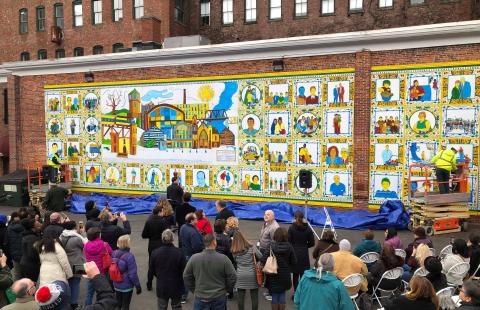What were the specific goals of this creative economy project? Describe the community development challenge or opportunity that your project was designed to address:
The project had a handful of clear goals. They included: 1. Create a beautiful mural in a bland downtown with a technique that ensured the artwork’s longevity. 2. Develop a narrative of Haverhill’s history that included all peoples’ stories and faces - directly addressing hateful language used by some in Haverhill towards newer immigrants. 3. Ensure that not only was the final artwork representative of this inclusive and diverse community, but that the process was as well.
If the goals change over time, please describe how:
n/a
Who was involved in this project and what did they do? (be sure to include the partners from outside of the creative sector and how local voices were included):
The mural was created by the lead artist, Alexander Golob, who had help from five local artists. The project’s steering committee included the artist, Alexander Golob, as well as State Representative Andres Vargas, Haverhill City Councilor Thomas Sullivan, and board members Paul Accardi and Dan Chabot Jr. from the Garibaldi Club, the non-profit that owned and fiscally sponsored the project.
The mural would have been impossible to create without the engagement from nearly 50 Haverhill families that submitted photographs and stories of their origin stories.
The project received funding and material from seven large funders including: Mass Development’s Commonwealth Places Initiative, the Garibaldi Club, the City of Haverhill, the Smart Growth Alliance, Haverhill Bank Pentucket Bank, and the Greater Haverhill Foundation. We also received support form nearly 40 crowd-funding supporters. Many – though not all – materials were donated or offered at discounted rates. Support here came from Shoe City Hardware, New England Sign Company, and the Sign Center.
All-Pro Electric, a member of IBEW Local 103, helped to install the mural and drop the curtain during the unveiling.
The Tap Brewing Company offered us a vacant first-floor windowed retail location to create the panels for the mural so that people could see the art as it was created over the three-month period of creation.
The Mayor of Haverhill, James Fiorentini, and the Economic Development Department provided invaluable support in receiving permits for the creation of the mural and for connecting us with sponsors.
The Haverhill Chamber of Commerce coordinated the unveiling of the mural. Helping the chamber was a group of volunteers who organized performances by local youth and found donation foods from several restaurants and individuals representing a broad variety of cuisines. The unveiling was had Congress woman-elect Lori Trahan, the first Portuguese-American woman to be elected to Congress in the history of the United States.
How does this project relate to a larger community development strategy?
This project fits well into three clear community development strategies already under way in Haverhill. First, it fit into the downtown’s designated cultural district. Second, it benefited local businesses by creating a more welcoming and active downtown. Third, it connects with an established push by local organizations and some leaders to make Haverhill more welcoming to its newer immigrant community.
What projects or places, if any, inspired your approach to this creative economy project?
This project was substantially influenced by the art of maiolica, a ceramic art invented in early Renaissance Italy. We borrowed colors, motifs, and stylistic choices from that project.
